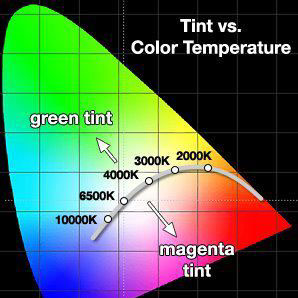
This is a beautiful representation of the CIE color model displaying color temperature in reference to color space and how warmer temperatures relate to colder colors and the same cooler temperatures in Kelvin are warmer whites and over all pictures. This is the basis of x and y color charting. I studied this long ago because years ago uniformity in displays was very hard to get and lead to confusion when features were converted to television! I was so lucky to work with Luminance Engineers one of witch actually perfected SMPTE C phospor for the bute color space and famous manufacturing moguls all of us with the same goal to bring a uniform picture with color fidelity that matched the films the features were edited from.

This is another color space chart a little more accurate in that the white is pictured but that would also or if you can imagine correspond to an emmited black space Max Planck's constant. What Planck discovered long before phospor or gas tube or LCD or LED, OLED as well you can emit additive light in a black or increase luminance never changing the temperature. The Black Body Radiator. That would be the temperature line depicted. Now on that line if you think of your monitor as a chalk board we will add active video hues colors luminance and create an active picture. The color temperature is important because it will change the whole look of the picture.

Another example of Planck's constant expressed in intensity and notice as peak is reached wavelength stays a constant there fore no color change.

THE INVENTION!
Knowing how Planck's constant worked and considering the only standard for monitor color temperature at the time was a optical unit called a Graphicon made in England by elevating the temperature of a precision light source. Now came the thought for invention and communication. Dr Morita at Sony, Claude Booth and Adam Yamamoto all came together to design the first color analyzer mark 1 prototype. We could now calibrate massive numbers of monitors in the field as well as the factory. If we received monitors as a product or replacement tubes any display which you could identify by the primary colors apart from the specified there was no subjective argument as before. This was a real break through in a consistent color rendition and a rock steady compass from which to paint colors in film to tape transfers as well as normal production. Everyone thinks this was designed entirely in Japan not quite Hollywood had something to do with it.
My thanks to Dr. Morita Sony
Adam Yamamoto Minolta
Chet Betima the SMPTE C phospor originator.
Knowing how Planck's constant worked and considering the only standard for monitor color temperature at the time was a optical unit called a Graphicon made in England by elevating the temperature of a precision light source. Now came the thought for invention and communication. Dr Morita at Sony, Claude Booth and Adam Yamamoto all came together to design the first color analyzer mark 1 prototype. We could now calibrate massive numbers of monitors in the field as well as the factory. If we received monitors as a product or replacement tubes any display which you could identify by the primary colors apart from the specified there was no subjective argument as before. This was a real break through in a consistent color rendition and a rock steady compass from which to paint colors in film to tape transfers as well as normal production. Everyone thinks this was designed entirely in Japan not quite Hollywood had something to do with it.
My thanks to Dr. Morita Sony
Adam Yamamoto Minolta
Chet Betima the SMPTE C phospor originator.

SMPTE color bars as specified from CBS labs in the late 1970's. I remember building just such a color bar generator for my Chief Engineer at The Vidtronics Company because the thought and theory of this was so new! It is widely used because it is 1 degree accurate with out a vector scope just using head end of bars on the video file or tape. It was and is a very clever thought reversing the blue content bars for I think 20 lines mid picture. CBS labs sent specifications out and I found the electronics and design to build one! Monitor set up and calibration we were known for all over the world.

Well this is where I started in video as a video engineer. To me even though a long time ago I will never forget seeing the first computer editing. One of the first big name quality post production and production houses. The first very frame accurate time code generator. The first copy protection system. The first color monitor calibration system and the technology used is very current today and this unit has a wider range of capture and better glass cut filters. True I was a very young man and things have changed. The basics were taught there construction, editing, DVE, film transfer, camera set-up and timing, edit bay set-up and timing all with much cruder electronics were done there. Allot of that is still used today and I have a better understanding how it's done which helps today. It is allot easier to time up and more forgiving with a frame synchronizer instead of just plain genlock also in editing you use insert and assemble edits in cuts only or added fades and dissolves. I was at a production house just recently and the Chief Engineer was just thrilled I knew how to work with the the older and newer equipment both.
